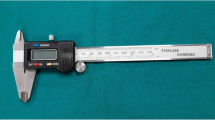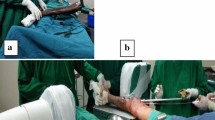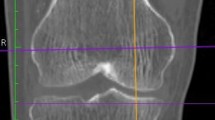Abstract
Purpose
The use of a TomoFix plate can be a challenge in Asian population who inherently have smaller tibial bones. This study aims to find out the normal proximal tibial morphometric measurements in Indian population and to compare the Medial Anterior Radius of Curvature (MAROC) of proximal tibia with the Proximal Part Radius of Curvature (PPROC) of the available TomoFix plates, to estimate conformity of the fit between them.
Methods
Retrospective Computed Tomography (CT) and Magnetic Resonance Imaging (MRI) based proximal tibial measurements were performed on 824 knees, 664 females and 160 males (604 patients). The mean MAROC, mean MAROC in males and mean MAROC in females were compared to the PPROC of TomoFix plates.
Results
The radiological measurements revealed a mean AP length of 45.22 ± 3.79 mm, mean ML width of 69.04 ± 5.01 mm and mean MAROC of 21.88 ± 2.11 mm. The mean MAROC in males was 24.07 ± 2.1 mm, whereas in females it was 21.35 ± 1.75 mm. The mean MAROC, mean MAROC in males and mean MAROC in females when compared to the PPROC of Standard TomoFix plate (38 mm), Small TomoFix and Anatomical TomoFix plates (30 mm) showed a significant difference (p < 0.01), indicating that the radius of curvature of the plate does not match the radius of curvature of the anteromedial tibial plateau.
Conclusion
The TomoFix plates, including Small (Asian Version) and Anatomical plates, are relatively large for the Indian population. Our study may help the implant to designers develop a plate that will better suit the Indian population, improving results and reducing hardware-related complications of MOWHTO.




(Source: TomoFix Medial High Tibial Plate (MHT) Surgical Technique, DePuy Synthes [21])



Similar content being viewed by others
Data Availability
The data that support the findings of this study are available from the corresponding author, [Gupta NR], upon reasonable request.
References
Guarino, A., Farinelli, L., Iacono, V., Cozzolino, A., Natali, S., Zorzi, C., & Mariconda, M. (2023). Long-term survival and predictors of failure of opening wedge high tibial osteotomy. Orthopaedic Surgery, 15(4), 1002–1007. https://doi.org/10.1111/os.13674
Han, J. H., Yang, J. H., Bhandare, N. N., Suh, D. W., Lee, J. S., Chang, Y. S., Yeom, J. W., & Nha, K. W. (2016). Total knee arthroplasty after failed high tibial osteotomy: A systematic review of open versus closed wedge osteotomy. Knee Surgery, Sports Traumatology, Arthroscopy, 24(8), 2567–2577. https://doi.org/10.1007/s00167-015-3807-1
Floerkemeier, S., Staubli, A. E., Schroeter, S., Goldhahn, S., & Lobenhoffer, P. (2013). Outcome after high tibial open-wedge osteotomy: A retrospective evaluation of 533 patients. Knee Surgery, Sports Traumatology, Arthroscopy, 21(1), 170–180. https://doi.org/10.1007/s00167-012-2087-2
DiffoKaze, A., Maas, S., Waldmann, D., Zilian, A., Dueck, K., & Pape, D. (2015). Biomechanical properties of five different currently used implants for open-wedge high tibial osteotomy. Journal of Experimental Orthopaedics, 2(1), 14. https://doi.org/10.1186/s40634-015-0030-4
Staubli, A. E., & Jacob, H. A. (2010). Evolution of open-wedge high-tibial osteotomy: experience with a special angular stable device for internal fixation without interposition material. International Orthopaedics, 34(2), 167–172. https://doi.org/10.1007/s00264-009-0902-2
Agneskirchner, J. D., Freiling, D., Hurschler, C., & Lobenhoffer, P. (2006). Primary stability of four different implants for opening wedge high tibial osteotomy. Knee Surgery, Sports Traumatology, Arthroscopy, 14(3), 291–300. https://doi.org/10.1007/s00167-005-0690-1
Jung, W. H., Chun, C. W., Lee, J. H., Ha, J. H., Kim, J. H., & Jeong, J. H. (2013). Comparative study of medial opening-wedge high tibial osteotomy using 2 different implants. Arthroscopy, 29(6), 1063–1071. https://doi.org/10.1016/j.arthro.2013.02.020
Han, S. B., Bae, J. H., Lee, S. J., Jung, T. G., Kim, K. H., Kwon, J. H., & Nha, K. W. (2014). Biomechanical properties of a new anatomical locking metal block plate for opening wedge high tibial osteotomy: Uniplane osteotomy. Knee Surgery & Related Research, 26(3), 155–161. https://doi.org/10.5792/ksrr.2014.26.3.155
Ahmad, M., Nanda, R., Bajwa, A. S., Candal-Couto, J., Green, S., & Hui, A. C. (2007). Biomechanical testing of the locking compression plate: When does the distance between bone and implant significantly reduce construct stability? Injury, 38(3), 358–364. https://doi.org/10.1016/j.injury.2006.08.058
Bottlang, M., Doornink, J., Fitzpatrick, D. C., & Madey, S. M. (2009). Far cortical locking can reduce stiffness of locked plating constructs while retaining construct strength. Journal of Bone and Joint Surgery. American Volume, 91(8), 1985–1994. https://doi.org/10.2106/JBJS.H.01038.PMID:19651958;PMCID:PMC2714811
Pochrząst, M., Basiaga, M., Marciniak, J., & Kaczmarek, M. (2014). Biomechanical analysis of limited-contact plate used for osteosynthesis. Acta of Bioengineering and Biomechanics, 16(1), 99–105.
Lee, S. S., Park, J., & Lee, D. H. (2022). Comparison of anatomical conformity between TomoFix anatomical plate and TomoFix Conventional Plate in Open-Wedge High Tibial Osteotomy. Medicina (Kaunas, Lithuania), 58(8), 1045. https://doi.org/10.3390/medicina58081045
Yoo, O. S., Lee, Y. S., Lee, M. C., Park, J. H., Kim, J. W., & Sun, D. H. (2016). Morphologic analysis of the proximal tibia after open wedge high tibial osteotomy for proper plate fitting. BMC Musculoskeletal Disorders, 17(1), 423. https://doi.org/10.1186/s12891-016-1277-3
Hussain, F., Abdul Kadir, M. R., Zulkifly, A. H., Sa’at, A., Aziz, A. A., Hossain, G., Kamarul, T., & Syahrom, A. (2013). Anthropometric measurements of the human distal femur: a study of the adult Malay population. Biomed Reseach International, 2013, 175056. https://doi.org/10.1155/2013/175056
Yue, B., Varadarajan, K. M., Ai, S., Tang, T., Rubash, H. E., & Li, G. (2011). Differences of knee anthropometry between Chinese and white men and women. The Journal of Arthroplasty, 26(1), 124–130. https://doi.org/10.1016/j.arth.2009.11.020
Kwak, D. S., Han, S., Han, C. W., & Han, S. H. (2010). Resected femoral anthropometry for design of the femoral component of the total knee prosthesis in a Korean population. Anatomy & Cell Biology, 43(3), 252–259. https://doi.org/10.5115/acb.2010.43.3.252
Kim, T. K., Phillips, M., Bhandari, M., Watson, J., & Malhotra, R. (2017). What differences in morphologic features of the knee exist among patients of various races? A Systematic Review. Clinical Orthopaedics & Related Research, 475(1), 170–182. https://doi.org/10.1007/s11999-016-5097-4
Mensch, J. S., & Amstutz, H. C. (1975). Knee morphology as a guide to knee replacement. Clinical Orthopaedics and Related Research, 112, 231–241. PMID: 1192638.
Phombut, C., Rooppakhun, S., & Sindhupakorn, B. (2021). Morphometric measurement of the proximal tibia to design the tibial component of total knee arthroplasty for the Thai population. J Exp Orthop., 8(1), 118. https://doi.org/10.1186/s40634-021-00429-9
Dai, Y., & Bischoff, J. E. (2013). Comprehensive assessment of tibial plateau morphology in total knee arthroplasty: Influence of shape and size on anthropometric variability. Journal of Orthopaedic Research, 31(10), 1643–1652. https://doi.org/10.1002/jor.22410
TomoFix™ Medial High Tibial Plate (MHT) Surgical Technique. Available via http://synthes.vo.llnwd.net/o16/LLNWMB8/INT%20Mobile/Synthes%20International/Product%20Support%20Material/legacy_Synthes_PDF/STG%20for%20TomoFix%20Anatomical%20-%20DSEMTRM011502883.pdf
TomoFix HTO Small Stature. Available via https://www.aofoundation.org/approved/approvedsolutionsfolder/2009/tomofix-hto-small-stature-asian-version#tab=clinical_cases; (www.aofoundation.org)
Chaurasia, A., Tyagi, A., Santoshi, J. A., Chaware, P., & Rathinam, B. A. (2021). Morphologic features of the distal femur and proximal Tibia: A cross-sectional study. Cureus., 13(1), e12907. https://doi.org/10.7759/cureus.12907
Bansal V, Mishra A, Verma T, Maini D, Karkhur Y, Maini L. Anthropometric assessment of tibial resection surface morphology in total knee arthroplasty for tibial component design in Indian population. Journal of Arthroscopy and Joint Surgery [Internet]. 2018;5(1):24–8. Available from: http://resolver.scholarsportal.info/resolve/22149635/v05i0001/24_aaotrstcdiip.xml
Niemeyer, P., Schmal, H., Hauschild, O., von Heyden, J., Südkamp, N. P., & Köstler, W. (2010). Open-wedge osteotomy using an internal plate fixator in patients with medial-compartment gonarthritis and varus malalignment: 3-year results with regard to preoperative arthroscopic and radiographic findings. Arthroscopy, 26(12), 1607–1616. https://doi.org/10.1016/j.arthro.2010.05.006. PMID: 20926232.
Sidhu, R., Moatshe, G., Firth, A., Litchfield, R., & Getgood, A. (2021). Low rates of serious complications but high rates of hardware removal after high tibial osteotomy with Tomofix locking plate. Knee Surgery, Sports Traumatology, Arthroscopy, 29(10), 3361–3367. https://doi.org/10.1007/s00167-020-06199-8
Darees, M., Putman, S., Brosset, T., Roumazeille, T., Pasquier, G., & Migaud, H. (2018). Opening-wedge high tibial osteotomy performed with locking plate fixation (TomoFix) and early weight-bearing but without filling the defect A concise follow-up note of 48 cases at 10 years’ follow-up. Orthopaedics & Traumatology: Surgery & Research, 104(4), 477–480. https://doi.org/10.1016/j.otsr.2017.12.021
Hayatbakhsh, Z., Farahmand, F., & Karimpour, M. (2022). Is a Complete Anatomical Fit of the Tomofix Plate Biomechanically Favorable? A Parametric Study Using the Finite Element Method. Arch Bone Jt Surg., 10(8), 712–720. https://doi.org/10.22038/ABJS.2022.60928.3003.PMID:36258741;PMCID:PMC9569138
Miller, D. L., & Goswami, T. (2007). A review of locking compression plate biomechanics and their advantages as internal fixators in fracture healing. Clinical Biomechanics (Bristol, Avon), 22(10), 1049–1062. https://doi.org/10.1016/j.clinbiomech.2007.08.004
Hayatbakhsh, Z., & Farahmand, F. (2022). Effects of plate contouring quality on the biomechanical performance of high tibial osteotomy fixation: A parametric finite element study. Proceedings of the Institution of Mechanical Engineers. Part H, 236(3), 356–366. https://doi.org/10.1177/09544119211069207
Funding
The authors did not receive any financial support or funding for the submitted work.
Author information
Authors and Affiliations
Contributions
NR Gupta was involved in protocol development and main manuscript writing. PO Baranwal performed data collection and manuscript editing. S Doering contributed to main manuscript. V Raina performed statistical analysis and manuscript editing. A Nayak was involved in figure preparation and manuscript editing. R Killekar collected data.
Corresponding author
Ethics declarations
Conflict of interest
Each of the authors states that he or she has no commercial associations (e.g. consultancies, stock ownership, equity interest, patent/licencing arrangements, etc.,) that might pose a conflict of interest in connection with the submitted article.
Ethical standard statement
This article does not contain any studies with human or animal subjects performed by the any of the authors
Informed consent
For this type of study informed consent is not required.
Additional information
Publisher's Note
Springer Nature remains neutral with regard to jurisdictional claims in published maps and institutional affiliations.
Rights and permissions
Springer Nature or its licensor (e.g. a society or other partner) holds exclusive rights to this article under a publishing agreement with the author(s) or other rightsholder(s); author self-archiving of the accepted manuscript version of this article is solely governed by the terms of such publishing agreement and applicable law.
About this article
Cite this article
Gupta, N.R., Baranwal, P., Doering, S. et al. Are TomoFix Locking Plates Really Anatomical for Indian Population?. JOIO 58, 495–502 (2024). https://doi.org/10.1007/s43465-024-01119-1
Received:
Accepted:
Published:
Issue Date:
DOI: https://doi.org/10.1007/s43465-024-01119-1




